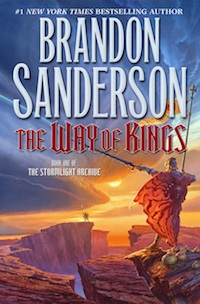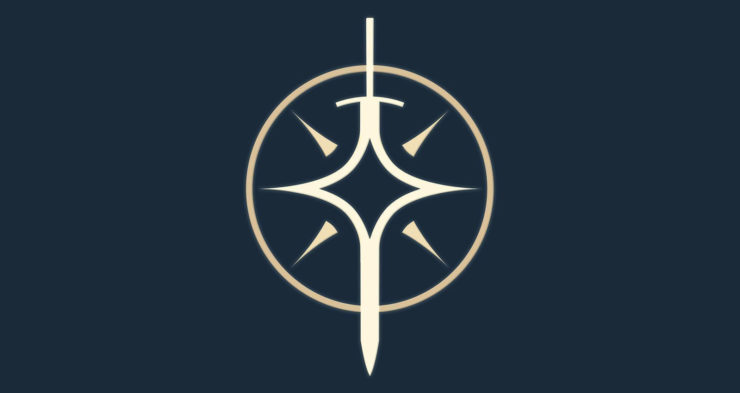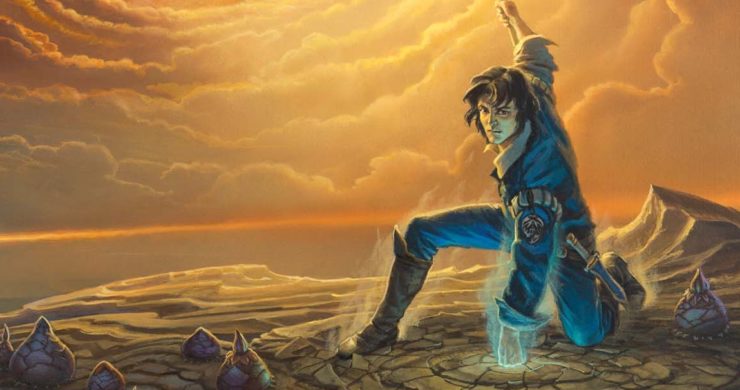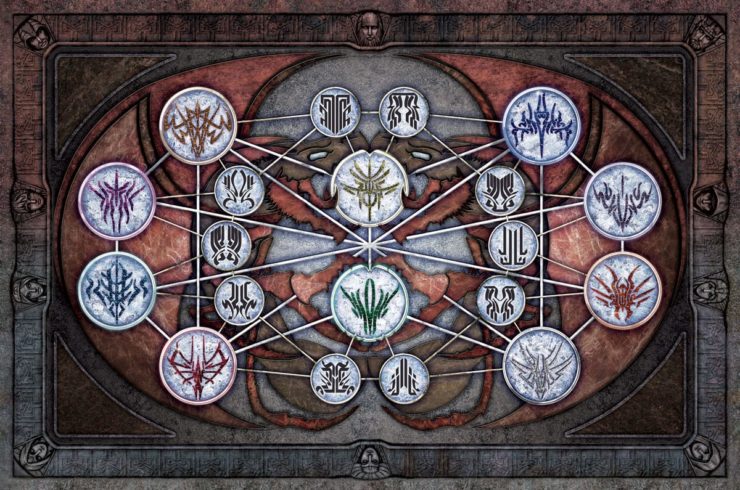This is where the action begins after a prelude filled with meaning, but little else besides two people jabbering about being tired. Granted, that jabbering was a very important discussion. With the prologue comes the impetus for the main action of the novel, and also one of the most controversial characters in The Way of Kings, namely Szeth, who is very much a conundrum from the onset. Even though he is perhaps the most powerful person we meet in The Way of Kings, most everything he does is at the behest of others, showing little outward will of his own. Don’t be concerned that the “What Happens” part of this post is so short. There is plenty to discuss with this chapter. Also, this is your reminder that spoilers abound below if you haven’t read the book at least once all the way through. You have been forewarned.
Time: 5 years before the current time of the rest of the novel. Approximately 4,500 years after the Heralds abandoned their roles in the Prelude.
Setting: Kholinar, capital city of the kingdom of Alethkar
Point(s) of View: Szeth (Szeth-son-son-Vallano of Shinovar)
What Happens
Szeth, Truthless of Shinovar is on a mission from his masters, the Parshendi, to assassinate Gavilar, the king of Alethkar. This takes place at the end of a celebration of a treaty between the Parshendi and Alethkar. Szeth accomplishes his mission by using his Shardblade, alongside his Stormlight-empowered skills and the three Lashings to defy gravity and hammer his way through the guards to the king. Szeth kills Gavilar after a back-and-forth battle. Gavilar’s last action is to ask Szeth to give a crystal sphere and a message to Dalinar, the king’s brother. Szeth leaves the message written in Gavilar’s blood, but keeps the sphere.
Quote of the Chapter:
“Have you seen me?” the man asked with slurred speech. He laughed, then began to speak in gibberish, reaching for a wineskin. So it was drink after all. Szeth brushed by, continuing past a line of statues depicting the Ten Heralds from ancient Vorin theology. Jezerezeh, Ishi, Kelek, Talenelat. He counted off each one, and realized there were only nine here. One was conspicuously missing. Why had Shalash’s statue been removed?
Is this the first appearance of one of the Heralds? That’s a big YES for me. This is the most blatant appearance of a Herald that I can recall, but I’m sure we’ll see others. Also, notice how the names of the Heralds have changed slightly since the Prelude? This is another device that shows how time has passed in the world, and that language and “known history” can change with time. The legends are real. It is just a matter of perspective.
Commentary
The first thing that pops out in the chapter is that odd epigraph. Excepting the interlude chapters, from here on out all of the chapters start with these somewhat mysterious quotes. A large parcel of these epigraphs are from people on their deathbeds. These were the most beguiling part of The Way of Kings for many, many chapters upon my first read, and once their provenance is revealed these will be the parts you’ll go back to reread to ferret out some context. We’ll discuss the other main types of epigraphs when we come to them.
So, we went from the Prelude, which had no action to speak of, right to some close-quarters combat that displays all the hallmarks of a good Sanderson fight scene and also does a good job of introducing how the magic on this world works. As with all Sanderson’s magic systems, the Lashings make logical sense. You have an energy source, which in this case is Stormlight, which pervades this world during, ahem, storms, that is then pretty much bottled in gems left out in the storm. These storms occur very regularly. The cause of them is so far unknown.
There was a small mention of spren in this chapter. Spren are some of the oddest inhabitants/spirits in the world of Roshar, and the first we’re told about are musicspren. Different spren are brought about by different emotions or actions. If music is played, then musicspren show up. If someone is injured then we get rotspren, and so on. Spren are one of the most inventive, yet oddly annoying aspects of The Way of Kings. As the story progresses we’re introduced to literally dozens of different types that seem to serve no purpose other than as window dressing. Well, except one type which we’ll hit upon in a couple chapters. There has to be some sort of greater purpose to all these spren beyond making the world look different.
I found the explanations of the Lashings weaved in perfectly with the action. Of course, you could just see the explanations of how Lashing works as tedious, but an admirable job was done to describe and illustrate each component well, without being too superfluous. To recap, the three Lashings are:
- Basic Lashing: Gives the ability to bind an object’s (including a person’s) gravity to another object, in any direction. Think of someone walking on the ceiling.
- Full Lashing: Binds objects together for as long as the Stormlight lasts, which is very useful to keep a foe in one place for a period of time.
- Reverse Lashing: Causes an object to draw other things to it like a magnet, which is perfect for directing arrows away from yourself. Unlike the other two, this Lashing requires continual contact to be made with the object.
I have a distinct feeling that the Lashings will be used in even more inventive ways as the story progresses in further volumes. For now, Szeth is our best window into the magic of the world. Shardplate interferes with Lashings in some way having to do with the gemstones that power the armor. This is most likely because performing a Lashing would drain the armor too quickly. Szeth is able to use a Shardblade quite well, though. A sword that won’t cut flesh, but severs your very soul from your body or that can leave a limb useless just brings out the fantasy kid in me.
So, Szeth is a Truthless, the meaning of which is still left open to a lot of interpretation even after reading the whole book. It isn’t even clear if Szeth is a typical Truthless, as there are mentions of him being something of black sheep to his people, but that will come in later. For now all we know is that Szeth must do whatever his masters command. In this case those masters are the Parshendi, who are not to be confused with the Parshmen. Although both the Parshendi and Parshmen share the characteristic skin of black marbled with red.
Many readers seem to have an active distaste for Szeth, but out of all the characters I find his backstory or lack thereof the most interesting. He is clearly highly trained in the ways of magic and mortal combat, yet he takes no pleasure in what he does. In fact, he wishes for an opponent that can best him so that he can die. He lives by a few simple rules that include following the orders of whoever own his Oathstone and not being able to commit suicide to escape his orders. But Szeth isn’t really a bad guy. He isn’t the “enemy” or even the antagonist of the story. He is a tool to make things happen, which is also how his masters treat him. So Sanderson is holding a lot back in regards to Szeth.
Another reason I find Szeth interesting is he also gives us a small look into Shinovar, a culture very remote from where the novel takes place. It seems like they have an Asian influence, and the land in Shinovar different from that of the rest of Roshar. Also, it seems the Shin, or at least the sect Szeth hails from, has access to a lot of lost knowledge, especially since he mentions during his fight in the palace that he is showing the Lashings to the Alethi, a group of people who haven’t seen such use of Stormlight in hundreds if not thousands of years. But why is it profane for the Shin to walk on stone? Could it be some connection to the beasts mentioned in the prologue that tore themselves from the ground? This chapter also has the first official mention of Stormlight in this case being used in a piece of jewelry, which Szeth also considers profane. Man, Szeth seems to find a lot about the Alethi profane.
Yet Szeth shows respect for the Alethi, even commenting that they still give off an air of nobility while they are drunk. Dalinar is briefly spotted, passed-out drunk, which is a very different light than we see him in for the rest of the novel, where is he is a much more heroic figure. So it seems Gavilar’s death will change Dalinar to some degree. It makes me very curious about what Dalinar was like before.
Honor is a big theme for Szeth and The Way of Kings in general, but Sanderson seems to be pushing it beyond the norm even for an epic fantasy. Szeth considers it his duty to do what he does even though he sees no honor in it, but to fail to fulfill his obligations would be tantamount to dishonor. A strange conundrum for a strange man.
Now on to things with even more implications. Why did the Parshendi want to kill Gavilar and start a war after going to the trouble of signing a treaty? Just to get in close? That makes little sense. Clearly Szeth could have gotten into the palace at some other opportunity had they wanted him to. Yet they wanted to make a show out of the regicide by signing the treaty and then committing the ultimate betrayal of said treaty. Are they really in charge, or is someone else pulling their strings, and Szeth’s in turn? The deeper the story goes the more I think the latter.
Most likely, this is all just the start to a new Desolation with the cycle of destruction returning. Which means the Voidbringers. Which means the Heralds are needed, along with the Radiants. At one point Szeth also mentions with some dismay that “the Alethi scholars were said to be close to creating new Shardblades.” So technology is once again advancing, and just when it might be needed most. Or this could be the hand of the Heralds nudging the world again.
After Gavilar is defeated he mentions that Thaidakar, Restares, and Sadeas were too late. Too late for what, though is never revealed, but it does sow a lot of unease in me as a reader, since Thaidakar, Restares, and Sadeas are all Alethi Highprinces. He too is baffled why the Parshhendi ordered his death. After learning this Gavilar, with his dying breath, asks Szeth to take a crystal sphere on a chain to give to his brother, along with the message that he “must find the most important words a man can say.” That simple statement moves Dalinar to action for the rest of the novel. It is mentioned that Szeth’s people always honor dying requests. Strangely, Szeth left the message but not the crystal. I’m not sure, but it feels like something Szeth wants to give Dalinar in person at some point. I smell setup.
In closing the chapter Szeth says “At least you won’t have to watch the world ending with the rest of us.” Questions, questions, questions….
Michael Pye (a.k.a. The Mad Hatter) runs The Mad Hatter’s Bookshelf & Book Review where he shares his views on genre books. He can also be found nattering on Twitter or in search of the perfect piece of bacon. He is currently working on an anthology project and is hoping to find a good publishing home for it soon.














